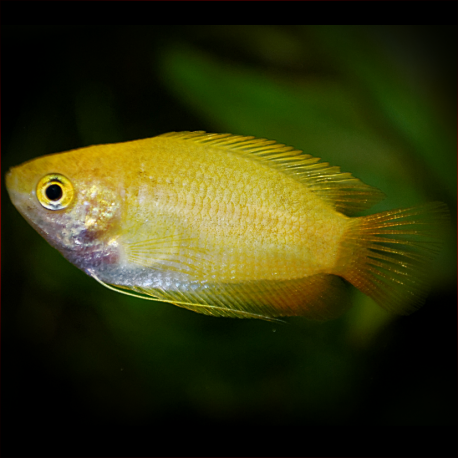More info
Datasheet
| Minimum Tank Size | 60 litres / 15.85 US gallons |
| Maximum Size | 5.5cm / 2.17inches |
| Temperature | 22°C / 71.60°F - 27°C / 80.60°F |
| Hardness | 2.02dgH / 36ppm - 15.02dgH / 268ppm |
| pH | 6.0-7.5 |
Behaviour:
Tankmates for the Honey Gourami should be chosen carefully, as they are slow-moving and can easily be intimidated or outcompeted for food by larger or more vigorous companions. Peaceful, pelagic cyprinids and less active loaches such as Pangio spp. are suitable choices. While not schooling fish, they do benefit from interactions with their own kind, showing more engaging behavior in groups of 4-6 individuals which develop noticeable hierarchies, often seen in dominant individuals chasing away rivals during feeding or territorial disputes.
Feeding and Diet:
In the wild, the Honey Gourami feeds on insects and small invertebrates. In captivity, they accept dried foods but should also be given live or frozen foods like Daphnia, Artemia, and bloodworms regularly to maintain optimal color and condition. Small insects like micro-crickets or fruit flies can also be fed to them after being filled with fish flakes or vegetable matter to diversify their diet.
Reproduction & Dimorphism:
The Honey Gourami is a bubblenester that forms temporary pair bonds during breeding. The male builds a nest and, after courtship with a female, spawns beneath it. The male guards the eggs and fry until they are free-swimming, at which point they should be fed infusoria or liquid fry food. Adult females are larger and have a brownish midlateral stripe, while non-nuptial males exhibit an orangish base color with yellowish fin margins, and nuptial males show bright orange bodies and dark blue to black accents.
Habitat and Distribution:
The Honey Gourami is typically found in low altitude, heavily-vegetated, sluggish waters like ponds, ditches, and flooded fields. They thrive in environments that undergo seasonal changes due to monsoons, which affect water volume, chemistry, and turbidity. Their natural habitat includes regions in northern India, Bangladesh, and Nepal, with commercial breeding being the primary source of specimens in the aquarium trade.

